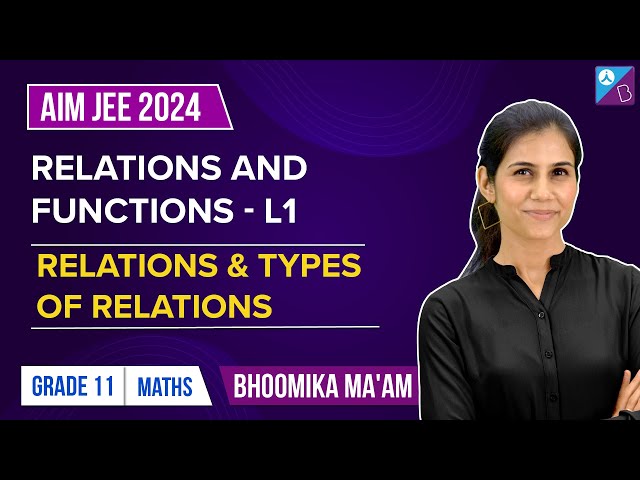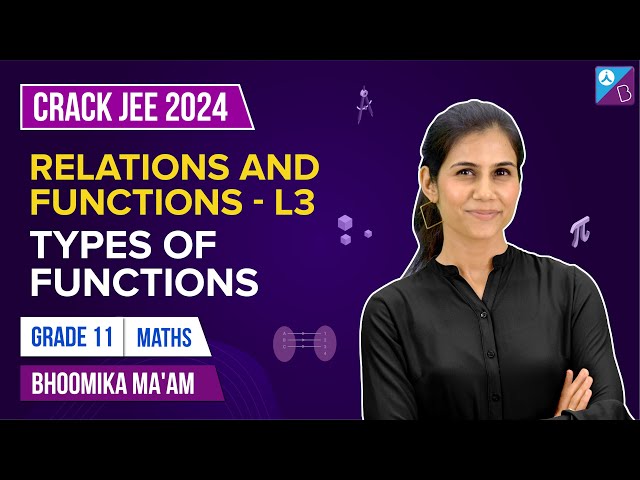In Mathematics, “sets, relations and functions” is one of the most important topics of set theory. Sets, relations and functions are three different words, having different meanings mathematically, but are equally important for the preparation of JEE Main. In this article, let us study the topic in detail for better understanding.
Download Complete Chapter Notes of Relations and Functions II
Download Now
Table of Contents
Sets in Maths
A set is a collection of well-defined objects. The objects of a set are taken as distinct only on the ground of simplicity.
A set of sets is frequently called a family or collection of sets. For example, suppose we have a family of sets consisting of A1, A2, A3,….. up to An, that is the family {A1, A2, A3,….., An } and can be denoted as
S = {Ai | i belongs to N and 1 ≤ i ≤ n}.
Notation: A set is denoted by a capital letter and represented by listing all its elements between curly brackets, such as { }.
Types of Sets
In sets theory, there are many types of sets. Some of them are discussed below.
Singleton set
A set contains only one element. For example, A = {3} and B = {pencil}. Here, A and B are containing only one element, so both are singleton sets.
Empty Set/Null Set
An empty set is a set with no element. It is denoted by A = { } or A = ϕ.
Proper set
If A and B are two sets, then A is a proper subset of B if A ⊆ B, but A ≠ B.
For example, if B = {2, 3, 5}, then A = {2, 5} is a proper subset of B.
Power Set
The collection of all subsets of a set is the power set of that set. If A is the set, then P(A) is denoted as its power set.
The number of elements contained by any power set can be calculated by n[P(A)] = 2n, where n is the number of elements in set A.
For example, if A = {1, 2}, then P(A) = {∅, {1}, {2}, {1, 2}}
Number of elements in P(A) = 22 = 4
Finite Set
A set contains a finite number of elements. For example, A = { 2, 4, 6, 8, 10} and B = { a, v, t}. There are 5 objects in set A and 3 elements contained in set B.
Infinite set
If the number of elements in a set is infinite, the set is called an infinite set. For example, N = set of whole numbers = { 0, 1, 2, 3, 4, 5, ……}.
Universal Set
Any set, which is a superset of all the sets under consideration, and usually it is denoted as S or U.
For example, Let P = {3, 4, 7} and Q = {1, 2, 3}, then we take S = {1, 2, 3, 4, 7} as a universe set.
Equal Sets
Two sets, P and Q, are equal if both are a subset of each other.
Mathematically, if P ⊆ Q and Q ⊆ P, then P = Q.
For example, P = {3, 6, 8} and Q = {6, 3, 8}
Here, P and Q have exactly the same elements. Satisfy the condition P ⊆ Q and Q ⊆ P.
Operations on Sets
In sets theory, there are basically three operations applicable to two sets, and they are as follows:
- Union of two sets
- Intersection of two sets
- Difference of two sets
Relations in Maths
A relation is helpful in finding the relationship between input and output of a function.
A relation R, from a non-empty set P to another non-empty set Q, is a subset of P X Q.
For example, let P = {a, b, c} and Q = {3, 4} and
Let R = {(a, 3), (a, 4), (b, 3), (b, 4), (c, 3), (c, 4)}
Here, R is a subset of A x B. Therefore, R is a relation from P to Q.
Types of Relations
Empty Relation
An empty relation (or void relation) is one in which there is no relation between any elements of a set. For example, if set A = {1, 2, 3}, then one of the void relations can be R = {x, y} where, |x – y| = 8. For an empty relation,
R = φ ⊂ A × A
Universal Relation
A universal (or full relation) is a type of relation in which every element of a set is related to each other. Consider set A = {a, b, c}. Now, one of the universal relations will be R = {x, y}, where |x – y| ≥ 0. For a universal relation,
R = A × A
Identity Relation
In an identity relation, every element of a set is related to itself only. For example, in a set A = {a, b, c}, the identity relation will be I = {a, a}, {b, b}, {c, c}. For an identity relation,
I = {(a, a), a ∈ A}
Inverse Relation
Inverse relation is seen when a set has elements which are inverse pairs of another set. For example, if set A = {(a, b), (c, d)}, then inverse relation will be R-1 = {(b, a), (d, c)}. So, for an inverse relation,
R-1 = {(b, a): (a, b) ∈ R}
Reflexive Relation
In a reflexive relation, every element maps to itself. For example, consider a set A = {1, 2,}. Now, an example of reflexive relation will be R = {(1, 1), (2, 2), (1, 2), (2, 1)}. The reflexive relation is given by,
(a, a) ∈ R
Symmetric Relation
In a symmetric relation, if a = b is true, then b = a is also true. In other words, a relation R is symmetric only if (b, a) ∈ R is true when (a,b) ∈ R. An example of symmetric relation will be R = {(1, 2), (2, 1)} for a set A = {1, 2}. So, for a symmetric relation,
aRb ⇒ bRa, ∀ a, b ∈ A
Transitive Relation
For transitive relation, if (x, y) ∈ R, (y, z) ∈ R, then (x, z) ∈ R. For a transitive relation,
aRb and bRc ⇒ aRc ∀ a, b, c ∈ A
Equivalence Relation
If a relation is reflexive, symmetric and transitive at the same time, it is known as an equivalence relation.
Types of Relations – Video Lesson

Relations and Types of Relations – JEE 2023 Exam Preparation

Domain, Co-domain and Range of a Relation
Let A and B be two sets. In the domain, co-domain and range of a relation, if R be a relation from A to B, then
- The domain of relation R (Dom(R)) is the set of all those elements a ∈ A such that (a, b) ∈ R for some b ∈ B.
- If R be a relation from A to B, then B is the co-domain of R.
- Range of relation R is the set of all those elements b ∈ B such that (a, b) ∈ R for some a ∈ A.
In short: Domain = Dom(R) = {a : (a, b) ∈ R} and Range (R) = {b : (a, b) ∈ R}
Note: Range is always a subset of co-domain.
Functions in Maths
A function is simply used to represent the dependence of one quantity on the other and is easily defined with the help of the concept of mapping. In simple words, a function is a relation which derives one output for each input.
A function from set P to set Q is a rule that assigns to each element of set P, one and only one element of set Q.
Mathematically: If f: A -> B, then y = f(x), x ∈ P and y ∈ Q. Here, y is the image of x under f.
⇒ Also Read
Functions and Its Types
Sets Relations and Functions Previous Year Questions with Solutions
Domain, Co-domain and Range of a Function
A function f from a set P to a set Q, represented as f: P-> Q, is a mapping of elements of P (domain) to elements of Y(co-domain) in such a way that each element of P is assigned to some chosen element of Q. That is, every element of P must be assigned to some element of Q and only one element of Q.
Domain:
For a function, y = f(x), the set of all the values of x is called the domain of the function. It refers to the set of possible input values.
Range:
The range of y = f(x) is a collection of all outputs f(x), corresponding to each real number in the domain. The range is the set of all the values of y. It refers to the set of possible output values.
For example, consider the following relation.
{(2, 3), (4, 5), (6, 7)}
Here, domain = {2, 4, 6}
Range = { 3, 5, 7}
Relations and Functions Important JEE Main Questions

Solved Examples
Example 1: Find the domain of the below function
Solution:
Here, |x – 2| = x – 2 if x ≥ 2 and |x – 2| = -(x – 2) or 2 – x if x < 2
|x – 2| – (x – 2) = 0 if x ≥ 2 and |x – 2| – (x – 2) = 4 – 2x if x < 2
So, the above function is defined for (-infinity, 2)
The domain of the given function is (-infinity, 2).
Example 2: Find the domain, co-domain and range of a relation pRq = p divides q.
If P = {3, 5, 7} and Q = {6, 12, 5, 9}.
Solution:
P = {3, 5, 7} and Q = {6, 12, 5, 9}
Since we have the relation between elements of P and Q is “p divides q”, then
R = {(3, 6), (3, 12), (3, 9), (5, 5)}
Therefore,
Dom(R) = {3, 5}
Co-domain of R = Q = {6, 12, 5, 9}
Range = {5, 6, 9, 12}
Recommended Videos
Relations and Types of Relations

Functions – Introduction, Co-domain and Range

Functions and Types of Functions

Range of Functions – Concepts & Questions

Relations and Functions Full Chapter Revision – 1

Relations and Functions Full Chapter Revision – 2

Relations and Functions Full Chapter Revision – 3

Frequently Asked Questions
What do you mean by sets in Mathematics?
A set is a collection of well-defined objects. For example, A = {1, 2, 3}.
What do you mean by a singleton set?
A singleton set is a set having only one element. For example, A = {6}.
What is an identity relation?
In an identity relation, every element of a set is related to itself only. For example, in a set B = {1, 2, 3}, the identity relation will be I = {1, 1}, {2, 2}, {3, 3}.
Define the domain of a function.
For a function, y = f(x), the set of all the values of x is called the domain of the function. It denotes the set of possible input values.
Define the range of a function.
Let y = f(x) be a function. Then, the range is the set of all the values of y. It denotes the set of possible output values.

Comments